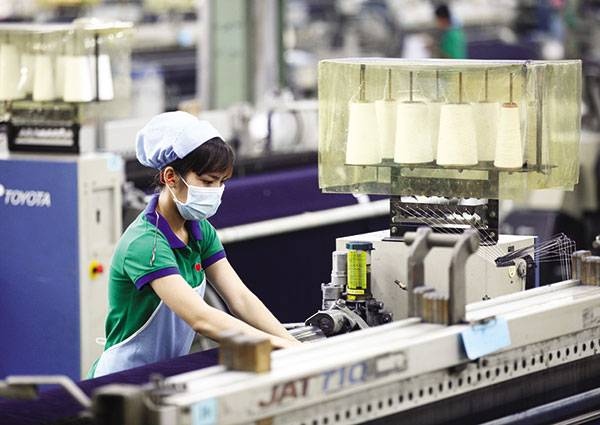Textile and clothing firms reluctant to implement Industry 4.0 practices
 |
| Industry 4.0 is revolutionising manufacturing, but the textile and garment sector is slow to adapt Photo: Le Toan |
Chairman of the Vietnam Textile and Apparel Association (Vitas), Vu Duc Giang said that, in the past a factory with 30,000 spindles for making thread required up to 450 labourers. In the wake of Industry 4.0, a factory of comparable size now requires only 30 labourers maximum.
A worker of old could only run two machines simultaneously. Now, one worker can operate 8-10 machines or even up to 12 machines at once. Therefore, when the spectre of Industry 4.0 sweeps across, a huge volume of workers will become superfluous.
Industry experts and sector insiders assume that Industry 4.0 will only affect specific sections of the value system, having little to no effect on activities higher up on the value chain – such as the design phase.
Pham Xuan Hong, chairman of the Ho Chi Minh City Association of Garment- Textile- Embroidery- Knitting (AGTEK), told VIR that some of their member units have invested in state-of-the-art equipment, but investment volumes remain modest.
For instance, Viet Tien Garment Corporation has bought automatic equipment for certain stages of their shirt production process, and Hoa Tho Corporation spent a large sum to modernise their suit production facilities.
Hong argued that about 50-100 steps are involved in making garment items, thus businesses will gradually automate their production processes ad hoc.
“The top concern of textile and garment firms at present is to ensure stable production and incomes for labourers,” Hong said.
Echoing his view, a source from French lingerie maker Scavi said that it is nearly impossible to automate the design process, as it caters to ever-changing fashion trends and customer tastes.
The company has invested heavily in new equipment and technologies in the past, but mainly for specific parts of production.
A recent International Labour Organization report shows that Industry 4.0 might make redundant 65 per cent of labourers in the textile, garment, and footwear industries in Indonesia, 86 per cent in Vietnam, and 88 per cent in Cambodia.
Vinatas’ deputy chairman Truong Van Cam said that the consequences might not be so serious, and the automation rate varies based on the production stage.
Experts, however, warned that textile and garment firms must find suitable growth paths for themselves.
Hong from AGTEK suggests making full use of current production capacity to increase accumulation and prepare resources for technology innovations.
“Two essential factors for businesses in the sector are investment capital and labourer skills,” Hong said, adding that most textile and garment businesses are concentrating on changing their business management methods. Additionally, they are also paying more attention to increasing sales in the domestic market.
What the stars mean:
★ Poor ★ ★ Promising ★★★ Good ★★★★ Very good ★★★★★ Exceptional
Latest News
More News
- Mondelez Kinh Do - a chapter of purpose-led leadership in Vietnam (December 18, 2025 | 09:44)
- VNPAY services receive the highest-level PCI DSS international security certificates for six consecutive years (December 17, 2025 | 23:47)
- PPL extends its reach into ASEAN (December 17, 2025 | 15:44)
- Over 600 BUV graduates meeting quality benchmarks across triple quality assurance levels (December 17, 2025 | 13:00)
- HEINEKEN Vietnam partners with Ho Chi Minh City Traffic Police on road safety drive (December 17, 2025 | 09:42)
- BUV and China’s CSCSE sign MoU to boost educational cooperation (December 17, 2025 | 08:00)
- PVT Logistics honoured with ‘Fast Enterprise Award’ at APEA 2025 (December 16, 2025 | 18:22)
- Empowering Sustainable Data Centers with Smart Infrastructure Solutions (December 16, 2025 | 13:59)
- Vietjet wins gold ESG transport sustainability award in Taiwan (China) (December 13, 2025 | 22:03)
- Legal framework completed for national digital transformation (December 13, 2025 | 21:55)


















 Mobile Version
Mobile Version